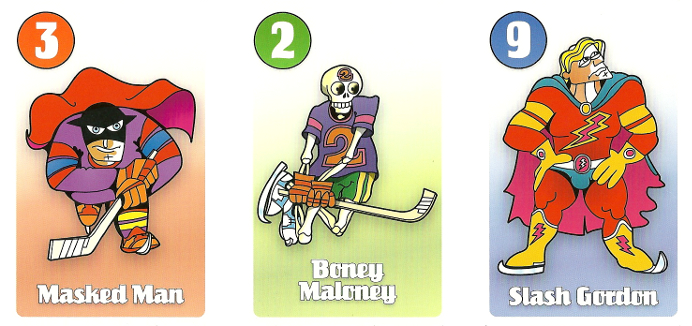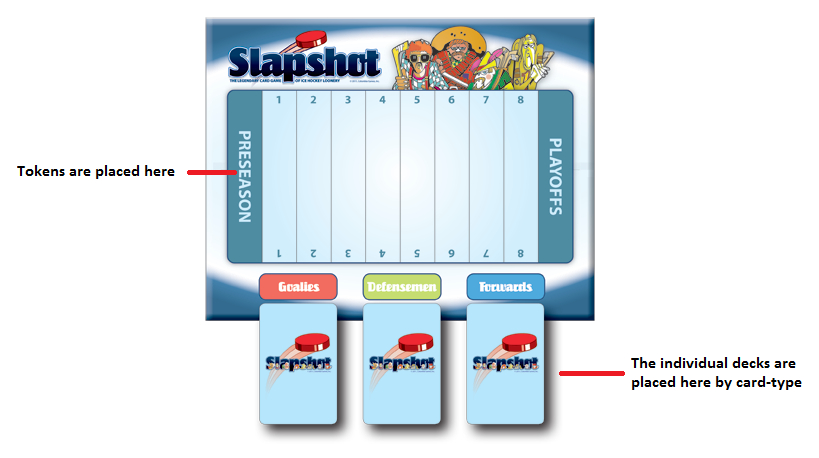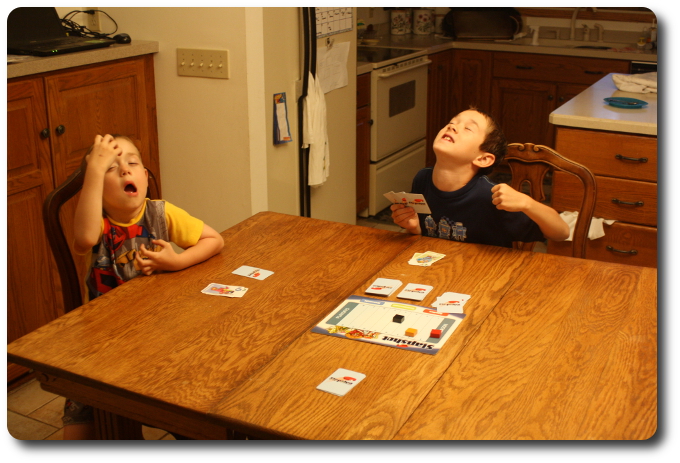
The Basics:
- For ages 5 and up (Publisher suggests 8+)
- For 2 to 6 players
- Approximately 45 minutes to complete
Geek Skills:
- Counting & Math
- Logical & Critical Decision Making
- Hand/Resource Management
Learning Curve:
- Child – Easy
- Adult – Easy
Theme & Narrative:
- Lead your ice hockey team to the playoffs and to greatness!
Endorsements:
- Gamer Geek rejected!
- Parent Geek approved!
- Child Geek approved!
Overview
The air is cool and the ice is smooth. All around you scream the fans and before you sits your team. They look up to you, their Team Manager, and wait for your words of wisdom before taking the ice. You have worked hard to create the best team possible, trading players and drafting new ones. A quick look at the opposite team tells you they think they have the advantage, but a game is not won until it’s played. And, baby, you can play a mean game of ice hockey.
Slapshot, designed by Tom Dalgliesh, Ron Gibson, John Gordon, Lance Gutteridge and published by Columbia Games, is comprised of 27 Forwards, 18 Defensemen, and 9 Goalies for a total of 54 cards. Included with the game is 1 Scoreboard and 6 square wooden game tokens (in six different colors, one for each player). The artwork on the cards looks to be HIGHLY influenced by Heinz Edelmann, the talented graphic designer and illustrator who brought us the 1968 animated Beatles film “Yellow Submarine“. All the game components are durable and are of excellent quality.
Pregame Locker Room Set Up
To set up the game, first place the Scoreboard in the middle of the game playing area and have each player select one of the tokens. Place the tokens on the space titled “Preseason” on the Scoreboard.
Second, separate the cards by type (represented by different colors). When completed, there should be three different piles of cards: 1 Forward pile (blue), 1 Defensemen pile (green), and 1 Goalie pile (orange). Shuffle each pile separately.

From left to right: Goalie, Defensemen, and Forward
Third, deal to each player 3 Forwards, 2 Defensemen, and 1 Goalie card from their respective decks, face-down. Players should pick up their cards, but keep them hidden from their opponents’ at all times. This represents the player’s starting hockey team.
Fourth, place each deck face-down underneath its labeled section found on the Scoreboard.

You are now ready to play some hockey! Let the season begin!
Slapping Pucks
Slapshot is played in turns with no set number of turns or rounds in a single game. A player’s turn is comprised of 1 of 3 possible actions. A player must select which action they want to take on each of their turns. A typical player’s turn is summarized here and described based on the action selected. Once a player completes their selected action, the next player in turn order sequence (going clockwise) takes their turn.
Draft
This action allows the player to discard one card from their hand, placing it at the bottom of the deck that matches the card-type selected. The player then draws the top card of the same deck they just placed their card under. For example, if the player selected a Forward, they would place the Forward card at the BOTTOM of the Forward deck and then draw the top card from the Forward deck. When completed, the player should have 1 new card with a total of 6 cards in their hand (3 Forwards, 2 Defensemen, and 1 Goalie).
Trade
This action allows the player to force an opponent to trade a card with them. The player’s opponent places their cards in a row, face-down. The player now selects, at random, one of their opponent’s face-down cards and adds it to their hand. The player must then take a card of the same card-type, but NOT the card they just drew, and give it to their opponent, face-down. When completed, both players should have 1 new card with a total of 6 cards in their hand (3 Forwards, 2 Defensemen, and 1 Goalie).
Game
This action allows the player to force an opponent to get on the ice and play a game of hockey! Both players organize their cards in their hand so as to determine the order in which the cards will be played. Cards will be placed face-down on the table in a deck during a “Game” action instead of held in the hand. This means that if a player wants a card to go first, it should be placed on the top of their deck so it’s the first card to be drawn.
Note that when a player initiates a “Game” action, they are considered the Visiting team. Their opponent is the Home team. Home teams automatically get a 1 goal advantage. Essentially, the score starts out as 0 to 1, with the player’s opponent currently winning the game as the Home team.
When both players are done and their cards are placed face-down in front of them in a deck, they will both draw their top card simultaneously and determine who wins. In almost all cases, the card with the highest number value (ranging from 0 to 10) scores a “goal”. Then both cards are set aside and each player draws the next top card from their deck to reveal the number. This continues until all 6 cards have been played. There are a few exceptions and some extra rules that should be noted.
- If both cards share the same number value, no goal is scored.
- A Goalie will almost always block an attempt to score a goal, regardless of the other card’s number value. There are two exceptions to this rule. First, if two Goalies faceoff, the Goalie with the highest number value will score a goal. Second, the “Tiny Tim” Defensemen card will always score against a Goalie.
- If a card is a “Bruiser” (indicated with a “plus” sign next to the card’s number value), they will injure their opponent’s card. A goal is scored or blocked as normal. The injured card is then set aside for the duration of the “Game” turn.

After the 6th card has been played, one of the participants in the “Game” action might have more goals than the other. This player has won the “Game” action and advances their token on the Scoreboard one space towards the “Playoffs”. If there were any injured Forwards, Defensemen, or Goalies, they are now replaced using the “Draft” action. This is a free action and is played out of turn starting with the Home team. Replacing injured cards must be done by both participants of the “Game” action before the player’s turn is over. All the players then pick up their cards. When completed, both players should each have a total of 6 cards in their hand (3 Forwards, 2 Defensemen, and 1 Goalie).
In the event that a “Game” action results in a tie, both participants play another “Game” action and the first player to score a “goal” will advance their token forward on the Scoreboard.
Playoffs
The game continues until a player moves their token into the “Playoff” space on the Scoreboard. This triggers the endgame. The player who just triggered the endgame and their opponent who is in second place, point-wise, will now play a series of “Game” actions (7 in total). The player who triggered the playoffs has home ice advantage for games 1, 2, 5, and 7. Their opponent has home ice advantage for games 3, 4, and 6. If there is a tie for second place, a best of 3 games is completed (semifinals, if you will). No “Trade” or “Draft” actions are available during the playoffs, but players must always replaced injured players after a game before starting a new “Game” action.
The player who wins the majority of “Game” actions during the playoffs wins!
Game Variants
There are two game variants that are explained in the game’s rules. We have summarized them here.
- League Schedule: This game variant forces all the players to participate in at least 1 “Game” action with each of their opponents before they can challenge another opponent to a second game. The Scoreboard is not used to keep track of individual players’ wins. Instead, a scorekeeper is designated. When each player has participated in 4 “Game” actions with each of their opponents, the top 2 players then participate in the playoffs as normal.
- Draft and Trade Limits: Players are limited to 4 “Draft” and 4 “Trade” actions per game. Injured players are still replaced as normal after a “Game” action.
House Rule
We created a House Rule to correct what we saw as a fault in the game. Feel free to use it, improve it, or completely ignore it.
- Shorter Season: Play until a single player wins 5 “Game” actions, which will then trigger the playoffs. The playoffs are the best of 3 games instead of 7.
To learn more about Slapshot, visit the game’s web page.
Prediction
Essentially, Slapshot is War with card drafting and deck management game mechanisms thrown in. This works, as the game’s theme and narrative asks the players to take on the roles of Team Managers. Trading and drafting is essential as a Team Manger in order to create the best possible team to play on the ice. Just based on the rules, game play is very straightforward and intuitive. The numbers used are small and there is no text other than the names of the wacky characters on the cards. This should allow young Child Geeks to have an opportunity to play the game without issue.
I believe Slapshot will do well with the Child Geeks and the Parent Geeks but will fail miserably with the Gamer Geeks. While the card drafting and the deck management aspects of the game would suggest that Slapshot has depth and strategy, it’s very thin on both accounts. The actual use of the cards, which is exactly like War, requires the players to just flip cards in hopes that theirs has a larger number value than their opponent’s. No additional thought is necessary or even possible. There is an opportunity here to collect nothing more than “Bruisers”, but since the “Trade” and “Draft” actions are blind, a player will find they are spending more time hunting for a card that might or might not be available in the deck versus interacting with the other players. There is also the overall duration of the game to consider. Individual “Game” actions are fairly quick (you are only ever playing 6 cards), but the number of times you have to use that action will get exceedingly repetitive. The 7-game playoff at the end of the game also sounds like it’s going to overstay its welcome with the Gamer Geeks.
Teaching Slapshot is a very simple exercise. Just tell your players what they need to do to win and you’ll be set. The number of actions available to each player is limited and straightforward, too, making the learning curve very easy, indeed. For the “Trade” and the “Draft” actions, the goal is to always get a better card, and the “Game” action goal is to win. And that’s really all there is to it. There shouldn’t be any confused players at your gaming table.
After teaching the game to my 5 and 8-year-old, they had no questions or concerns with what they had heard. And so, as I shuffled the cards, I asked them both their thoughts on the game so far.
“This is War on ice, which sounds like a movie.” ~ Liam (age 8)
“I really like the characters on the cards! Can I see them all when we are done playing?” ~ Nyhus (age 5)
The illustrations on the cards are indeed eye-catching. Let’s see if the game is as fun to play as it is to look at or this simple card game falls through the ice.
Final Word
The Child Geeks had a great time with Slapshot, but the overall game length went a bit long for them. That’s why we created the House Rule we noted above. For the older Child Geeks, the normal duration of the game wasn’t any problem. They stayed focused and participated throughout. The younger and less experienced Child Geeks started to drift away from the table as the game continued. According to one Child Geek, “The game is OK, but it gets a bit boring with all the other players in the game taking long turns.” And by “long turns”, the Child Geek was referring to the “Game” action. The “Draft” and the “Trade” actions are very quick, but the Child Geeks went a bit slower with the “Game” action. When we reduced the overall game length, the younger Child Geeks had no problem being as active and engaged as their older peers. All the Child Geeks voted to approve the game with some of them liking it a bit better than others, but all of them happy with the overall game playing experience.

My little geeks ham it up for the camera…
The Parent Geeks were less enamoured with Slapshot, but found it to be an enjoyable experience as a family game. When played with just their peers, Slapshot didn’t do as well. According to one Parent Geek, ” This game is just a bit too easy and repetitive for me, even though I prefer casual games over harder games.” Slapshot is very casual and very easy to play. This resulted in a reduction to the overall level of “fun” the game provided for the Parent Geeks. Introduce Child Geeks, however, and the view of Slapshot quickly changed. “This is a lot of fun to play with my kids and a great way to get them interested in playing more complicated games,” said one Parent Geek and there were head nods of approval around the table. In the end, the Parent Geeks voted to approve Slapshot, finding it to be an easy game to learn, fun to play with the family, and a great excuse to talk about hockey. But as a casual game to be played with just adults, they suggested that Slapshot missed its goal.
Gads were our Gamer Geeks bored. And when they are bored, they get belligerent. Mostly towards me because I am “forcing them” to play games they would have otherwise not wanted to play. The overall game play was found to be way too simple and way too repetitive for the majority of the Gamer Geeks. Even those elitists who have no problem playing casual games were yawning and became more and more interested in what their smartphones were telling them versus the game play at the table. In fact, the Gamer Geeks kept asking me if they were playing the game right after reading several comments on Board Game Geek that suggested that Slapshot was a game they would enjoy. According to one Gamer Geek, “This is not a game I will ever play again. It is too long, too repetitive, and too mindless.” Another Gamer Geek stated, “This is War with card drafting and nothing more.” Only 10 minutes into the game, and all the Gamer Geeks just started to take the “Game” action towards each other in an attempt to get the game done. You should have seen their faces when I told them that the players in first and second place had to go through 7 games. Hilarity. All the Gamer Geeks voted to reject Slapshot and asked that it never again be brought to their gaming table.
Personally, I wasn’t all that impressed with Slapshot. It’s “War on ice” (to quote my little geek), with the only interesting aspects of the game play being the trading and drafting actions that allowed me to tailor my deck. But overall, the game felt bogged down by its simple repetitive actions and length of play. Slapshot was a fun time with my little geeks, but those are the only players I enjoy playing the game with. Adults don’t seem enthralled with the game’s approach to “fun” and the Gamer Geeks would prefer to watch paint dry. When smack talking at the table was present, the game was a lot more entertaining, but the game’s overall length and repetitive nature started to push the players away instead of keeping them engaged. A pity, as the game does makes use of some interesting and easy game mechanisms.
I’d be hard pressed to suggest this game to another adult player. There are more interesting card games available today that are just as easy to learn and I find more entertaining. Slapshot is not a bad game by any means, but it is very simple. And its simplicity leads me to believe, based on our observations, that this game would be a good one for families and Child Geeks, but would have a difficult time scoring points with more mature and experienced game players.
This game was given to Father Geek as a review copy. Father Geek was not paid, bribed, wined, dined, or threatened in vain hopes of influencing this review. Such is the statuesque and legendary integrity of Father Geek.




Nice detailed overview, Cyrus! New, news:
Slapshot is also available for Apple iOS. Its FREE! https://apps.apple.com/us/app/slapshot/id475515609